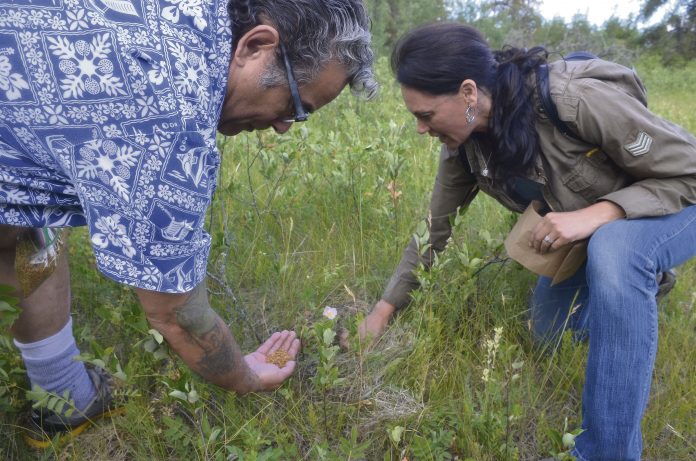
Volunteers harvest plants for educational healing garden while protecting vulnerable species from damage
“Sage is a woman’s medicine, important for spiritual care.”
Leah Dorion kneels down near the entrance to what will be the future Kistapinanihk garden area. A small sage plant is hanging on near the edge of the native grassland in the area, clinging to the border of the beaten track and the wild bush. She takes a few pinches of tobacco out and gently sprinkles it over the plant. Then, she kneels down and takes the seedpod, placing it gently in a brown paper bag.
Dorion is joined by John Hannikenne, one of the leaders of the Kistapinanihk initiative, as well as by food bank executive director Wes Clark and a few volunteers.
She leads the group around the main path, identifying indigenous plants that can be transplanted or harvested for seeds. The plants and seeds will be transplanted into the new Oasis garden, located by the old Molson brewery in town.
The main path will become part of a future cultural healing area, home to heavy foot traffic. Several areas will be preserved, but on the main path, the delicate plants are vulnerable.
By taking these plants today, Dorion and her band of volunteers are protecting the plants, all while building an educational, spiritual ecosystem at the Oasis garden.
As she walks, Dorion identifies good specimens for transplant. She points out some healthy brown-eyed Susans, two types of sage, wild roses and wild strawberries.
Certain plants are dug up for transplant, fresh soil and dried tobacco left in their place.
Others, she leaves be, as some of the more robust plants, like the yarrow, will have no trouble surviving in the healing space.
“It’s like we’re on a seed hunt,” Dorion says. “Just in this walkaround of the impacted area, we have enough.”
The purpose of the new garden, one of many being established in the Oasis Community Gardens, is two-fold. Not only will it protect native grassland species, it will also serve as a place for education and healing. It will be open for people to come and learn about the species and their traditional uses.
“People can come visit, they can come check it out and they can get that education,” Dorion says.
“We encourage all people to take responsibility too. If you’re putting in a garden and you’ve got a lot of wild prairie, relocate it somewhere else, or keep the seeds and spread them around.”
While the education piece is important, that protection is vital, as natural prairie grasslands are disappearing at an alarming rate.
For more on this story, please see the July 19 print or e-edition of the Daily Herald.

